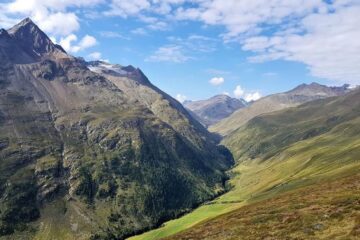Ocean seep mollusks may share evolutionary history with other deep-sea creatures

The unusual mollusks of oceanic cold seeps–strange clams, mussels and sea snails that thrive in the sulfur and methane-rich environments–are on average older than the marine mollusk community as a whole, according to a new report in the 8 September issue of the journal Science, published by AAAS, the nonprofit science society.
On average, the first appearance of cold seep mollusk genera in the geological record is a full epoch earlier than that of marine mollusks in general, according to Steffen Kiel and Crispin Little of the University of Leeds.
These findings indicate that the long evolutionary history of the seep mollusks is more similar to that of other deep-sea animals than to some of their mollusk contemporaries from other parts of the oceans.
Cold seeps may have been–and continue to be–safe harbors for the mollusks, protecting them from mass extinctions and possible abrupt oxygen changes in the seas, the researchers found. However, many deep-sea species outside of the cold seeps have also managed to ride out these changes.
„The shallow water environment is much more challenging, subject to changes in sea levels, extinction events, pollution, sediment runoff–all sorts of factors which don't affect animals in the deep sea,“ Little explained.
This makes it difficult to tell whether seep mollusks owe their long evolutionary history to their unique home environment or to their status as deep-sea creatures, he noted.
Cold seeps are places where fluids rich in hydrogen sulfide and methane leak up through the ocean floor, creating a unique chemical environment where hardy bacteria process the sulfide and methane. Seep fluids are about the same temperature as surrounding waters, but similar chemically challenging environments exist at hydrothermal vents, fissures in the ocean floor where water is superheated by magma lurking just below the crust.
Although seep and vent fluids are a poisonous brew for most species, animals such as giant tube worms and the mollusks studied by Kiel and Little thrive with the help of the symbiotic bacteria. „If you can become adapted to living at these sites, you can make a very good living indeed,“ Little said.
The origins and age of seep citizens such as the mollusks has been debated for some time by scientists using both fossil and genetic evidence. Kiel and Little decided to examine the fossil record for modern seep mollusks to see how their history compared to that of the overall marine mollusk population.
By sorting 29 mollusk genera into the geological time periods when they first appeared, the researchers found that seep mollusk genera, on average, appeared during the Eocene epoch about 55 to 34 million years ago. By contrast, the average age of first appearances for all marine mollusks occurred in the Oligocene epoch, about 34 to 24 million years ago.
Following the fortunes of seep mollusks through time, Kiel and Little also found little evidence that mass extinction events or periods of low oxygen dealt significant blows to the seep communities. Seeps may have been good shelters during these events because „they were driven by a constant source of geothermal energy,“ Little said.
The Eocene age calculated by the Science researchers casts some doubt on another mystery involving seep animals: what is their relationship to whale falls? Whale falls, the slowly decaying remains of large whales sunk to the ocean's depths, harbor yet another unique chemical community similar to that in vents and seeps.
Some researchers suggest that whale falls were evolutionary „stepping stones,“ creating new environments for seep animals to evolve into a plethora of new species. But Kiel and Little's work shows that more than three-quarters of seep mollusk genera had already appeared by the time oceangoing whales would have filled the seas.
Whale falls „are not instrumental in the evolution“ of seep mollusks, but the falls „may have allowed them to expand into new sites,“ Little explained.
„Cold seep mollusks are older than the general marine mollusk fauna“ by Steffen Kiel and Crispin T.S. Littleat the University of Leeds.
Media Contact
Weitere Informationen:
http://www.aaas.orgAlle Nachrichten aus der Kategorie: Ökologie Umwelt- Naturschutz
Dieser Themenkomplex befasst sich primär mit den Wechselbeziehungen zwischen Organismen und den auf sie wirkenden Umweltfaktoren, aber auch im weiteren Sinn zwischen einzelnen unbelebten Umweltfaktoren.
Der innovations report bietet Ihnen interessante Berichte und Artikel, unter anderem zu den Teilbereichen: Klimaschutz, Landschaftsschutzgebiete, Ökosysteme, Naturparks sowie zu Untersuchungen der Leistungsfähigkeit des Naturhaushaltes.
Neueste Beiträge

Klimakrise gefährdet alpine Ökosysteme
Gebirge sind vom Klimawandel besonders betroffen: Sie erwärmen sich schneller als das Flachland. Mit der Erwärmung schwindet die Schneedecke und Zwergsträucher dringen in höhere Lagen vor – mit starken Auswirkungen…

Bakterien für klimaneutrale Chemikalien der Zukunft
Forschende an der ETH Zürich haben Bakterien im Labor so herangezüchtet, dass sie Methanol effizient verwerten können. Jetzt lässt sich der Stoffwechsel dieser Bakterien anzapfen, um wertvolle Produkte herzustellen, die…

Batterien: Heute die Materialien von morgen modellieren
Welche Faktoren bestimmen, wie schnell sich eine Batterie laden lässt? Dieser und weiteren Fragen gehen Forschende am Karlsruher Institut für Technologie (KIT) mit computergestützten Simulationen nach. Mikrostrukturmodelle tragen dazu bei,…





















